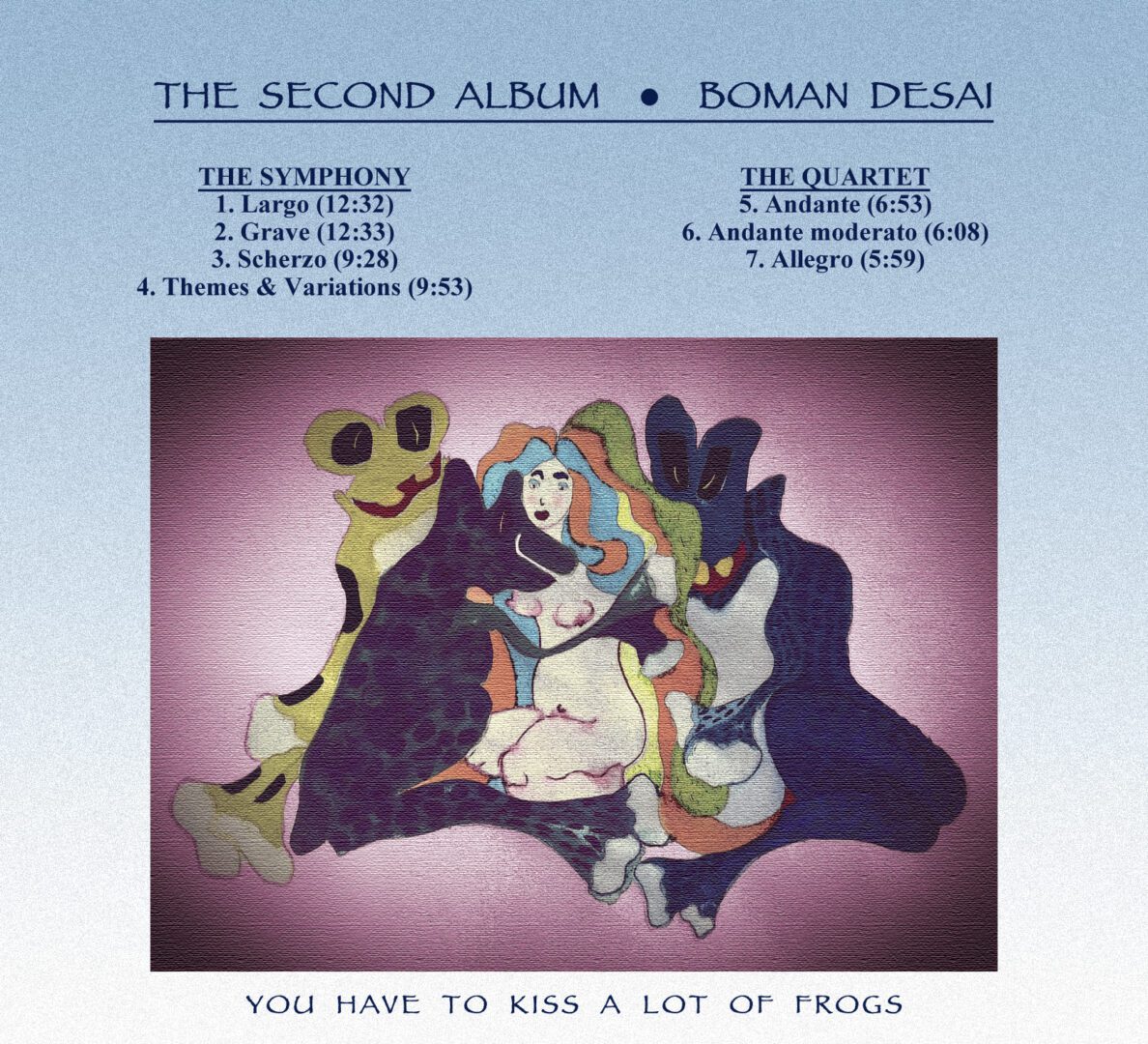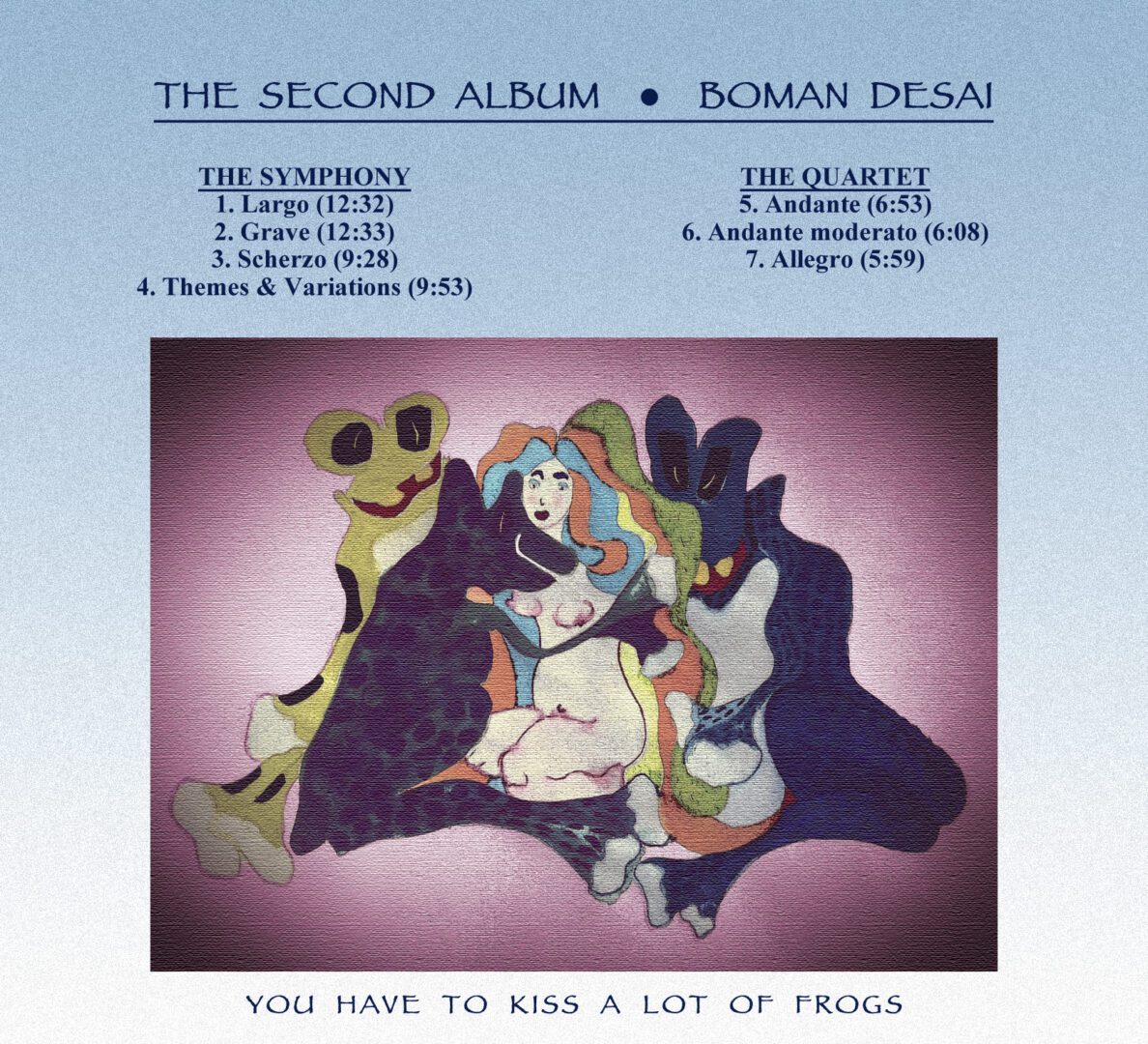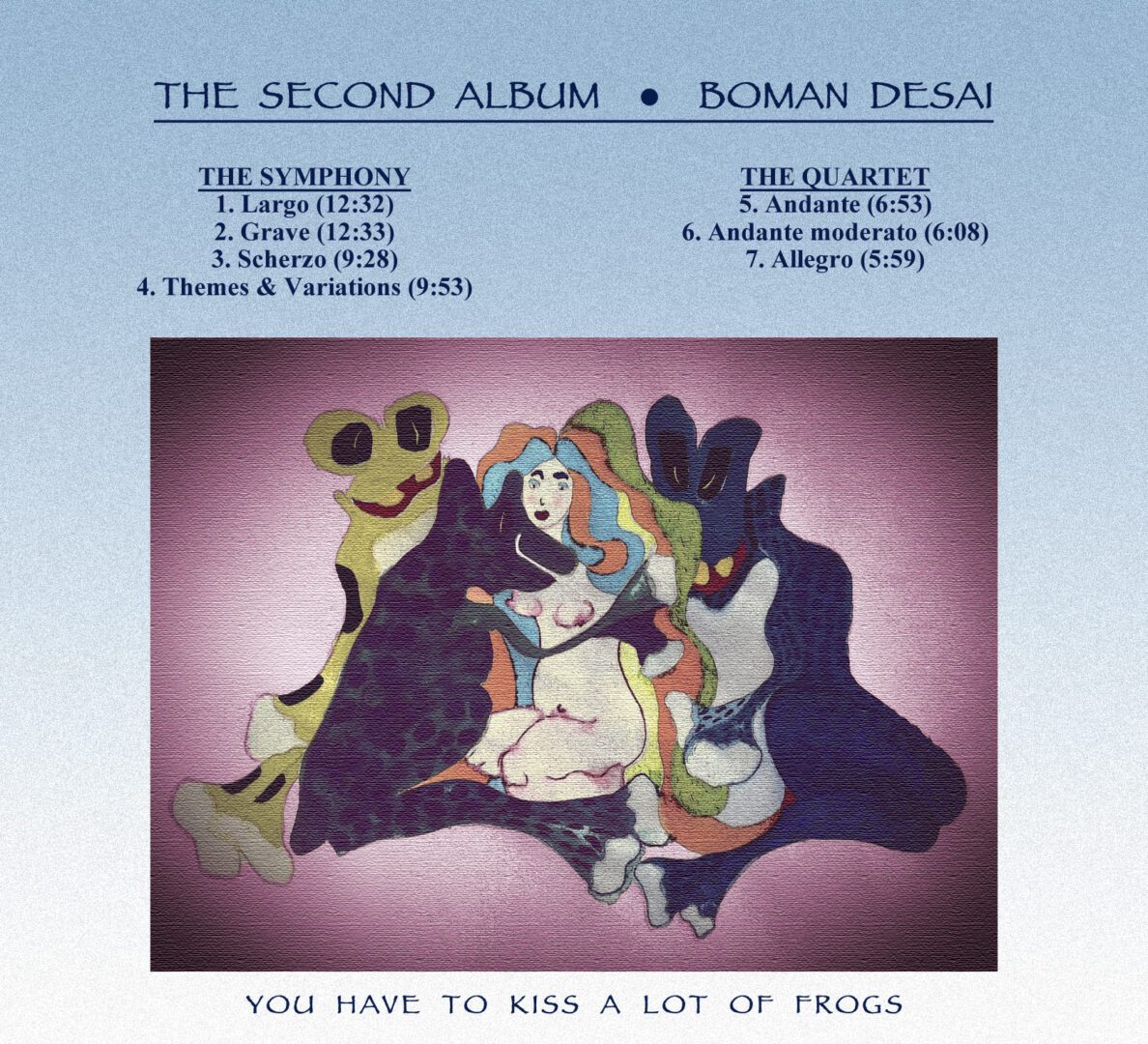THE SECOND ALBUM
Please click on any of the three images to hear different snippets from the Symphony or Quartet.
SYMPHONY
Dedicated to Ronnie Desai
The First Movement (Largo) in Sonata form (Exposition, Development, Recapitulation), comprises two themes: the first, a study in Frustration, the second a contrasting theme in Grace. The Frustration theme opens with bassoons in a funereal climb toward a peak, before dropping like a sledgehammer down a 12-note chromatic scale. The orchestra scurries up and down this chromatic scale until clarinets crawl from under the melee and horns blanket the tumult to announce the second theme. Opening on trumpets and trombones, the second theme is joined by winds and strings, rising in pitch and tempo, bringing us to the close of the Exposition. The Development pits the two themes against each other in a conflict favoring now Frustration, now Grace, until Frustration, clearly exhausted, limps to the finish on clarinets, pizzicato strings, and flutes. The Recapitulation opens (as did the Exposition) with rising bassoons, but whereas the Exposition rose in a funereal march the Recapitulation rises in a festive minuet, leading to a thunderous climax—but, since this is just the first of four movements, the thunder gives way to a soft rain of winds and brass and a final blip in pizzicato.
Perhaps the most elusive part of any composition is the initial inspiration. I took the rising section of the Frustration theme from a song I wrote during the 1970s, “Through Another Year,” about a couple imagining their best years behind them. The falling section of the theme appeared a couple of years later. I had done something incredibly foolish about which I was ashamed and hammered out my frustration on the piano on February 28, 1980, accounting for the downward chromatic sweep. If you close your eyes you can visualize me tearing out my hair. The study in Grace (but for one note) is identical to the Rondo theme of Beethoven’s Violin Concerto which I first heard as a child—but I didn’t recognize the similarity until the work was complete. I had taken off instead from a theme by Henry Mancini (from The Wonderful World of the Brothers Grimm) before it morphed into Beethoven’s Rondo.
The Second Movement (Grave), like the first, has two themes, but the themes don’t intersect as in the first, proceeding instead in an ABA format. The first A section, opening with a subterranean G on bass, is soon joined by pizzicato cellos, violas, and highpitched pizzicato violins. The measures alternate between G major and G minor until brass and timpani raise the orchestra to a shining climactic G major chord—but barely two minutes into the movement the climax has arrived much too soon. The horns attempt to repeat the climax, only to fall to an unexpected and ominous B flat minor. Fear and disarray follow, horns and violins screaming outrage. The movement has yet to find its legs (let alone its wings) and retreats into itself.
The B section opens simply, aware in the wake of the tumult of the A section that it needs to walk before it can run. The walk ripens into a waltz, clarinets and violins dancing around each other, to introduce a ditty fit for a popular song. Once stated, the ditty leaps into a beanstalk of variations, descending finally to the original subterranean G note, preparing once more to ascend. The brass, mature from its earlier experience, doesn’t go immediately for the kill. The progress, instead, is sure and unhurried. There is no more confusion. Horns rise and fall, gallantly surrendering a turn to trembling strings, which in their turn surrender to humming clarinets and droning bassoons. The section has found its legs and is soon to find its wings. The bountiful melody plays out in full as the orchestra rises again, vaulting the original G major chord, to the crest of a shining C major. Shimmering strings follow, horns rise in a sadder and wiser minor key, clarinets and oboes exhibit a new and plaintive trim. The movement doesn’t conclude as much as evaporate into air.
The melodies for this movement have been with me even longer than the first. The A section developed from “Pearly Shells,” a song I knew by Pat Boone, released in 1965, though the song itself was recorded earlier by Burl Ives and taken from an old Hawaiian tune. I took the first 3 notes of the melody, b-d-g, and built the rest of the section on those notes.
The ditty was composed by a favorite aunt (a friend of my mother), Gool Paymaster, from whom I took piano lessons for a summer (around 1960), a lovely woman whom I’m so very glad to be able to memorialize this way. Her husband, Keki (an economist), played the violin, and my earliest memories of Beethoven’s Kreutzer Sonata stem from performances in their sitting-room.
The Third Movement (Andante) is a Scherzo, by definition playful, propulsive, humorous, sand-wiching a contrasting section called the trio (ABA). This Scherzo has two trios (ABACA). The first A lurches toward the first trio (B), the lightest part of the symphony, wafted on flutes and cellos. The middle A, a muscular development of the first, provides the first appearance of the harp in the symphony. The second trio (C), an unapologetically pretty waltz, might easily have found a home in nineteenth century Vienna. The final A repeats the first varying the orchestration before concluding with a sudden brief coda.
The Scherzo melody (A) came from a song I wrote in the 1970s, “The Inner City Blues,” about hard times I was going through. Music has provided a release for me since I was a teenager and I’m so very grateful to be able to piece various segments of my life together as I have in this symphony (and other compositions). Both trios, on the other hand, B&C, are brand new, both composed in 2019 for the Scherzo. I sat, giving the Scherzo melody free rein in my head, and the trios appeared.
The Fourth Movement (Allegro) is a Theme and Variations with a difference. Instead of just one, there are 2 related themes, each begetting a set of variations: AA1A2BA3A4B1A5A6A7A8B2A9C. The melody for the first theme (A) comes from a song I wrote in the 1970s. I was in the process of writing songs related to the Medieval Era. Among others, I wrote songs about jesters, peasants, nuns, and this song, “Candles for Maria,” about a maid charged with lighting candles in a castle. Just about everyone else has perished in a battle, but she continues to light candles as if nothing has happened. The bridge of the song was influenced by Pink Floyd’s “Eclipse” from Dark Side of the Moon, which had then just been released. Later, during the 1980s, I changed the lyrics and the song became “The King and Queen of Trickle-Down” (no prizes for guessing the identities of the king and queen). The Coda of the movement (C) quotes from the first and second movements of the symphony, providing unity to the whole.
The lyrics of the songs have nothing to do with their placements in the symphony. The first theme from the first movement derived from “Through Another Year” has nothing to do with a mismatched couple in the symphony, the Scherzo adapted from “The Inner City Blues” is not a 12-bar blues, nor is the fourth movement theme from “Trickle-Down” about politics/economics. The songs provide stepping stones to the final incarnations. The themes may represent parts of my past, but are transformed into abstractions of those events, perhaps as an abstract painting develops from a concrete form.
QUARTET
The first theme of the First Movement (Andante), in Sonata form, stems from a song, “Chameleon,” written during the 1970s, about a man willing to change everything about himself for the woman he loves. The lyrics were farcical (Let me be your Gentle Jim / Yielding to your every whim. / Let me be your Jealous John / I’ll smash the guys you smile upon … and so on), but what I liked best about the song was its rhythm. I accompanied myself singing with the guitar, using only bar chords, which allowed a strident chopping rhythm I had not used before, punctuated by scurrying sixteenth notes. The second theme, sweet and docile and shorter by contrast, created specifically for this movement, generated far greater headaches. The fugal form which suggested itself is not one with which I am familiar. The Development borrows elements from both themes, pitting martial 1st against pensive 2nd. The Recapitulation concludes quietly, but a brief coda fiercely recalls the first theme.
The Second Movement (Andante moderato) stems from another of my medieval songs, “The Nun’s Prayer” (see note on 4th movement of the Symphony), also written during the 1970s, also written farcically, nuns praying for a man, but I changed the lyrics later to nuns praying for mankind—at long last, maturity?
The movement opens with a quiet unassuming introduction from which I planned to develop the themes, but I was thwarted. I had planned an ABABA structure, A representing the chorus of the song, B the verse, transitional passages (t) linking the sections—but the transitional passages grew like hedgerows, threading the movement, becoming almost a third theme. The last statement of the first theme gave rise to a form without precedent (to my knowledge): a cadenza for a quartet. A cadenza is an improvisation on the major themes of a piece, usually concluding the first movement of a concerto, usually left to the soloist’s imagination, meant to be improvised live, not composed beforehand—but in time even cadenzas came to be pre-composed. Clara Schumann once apologized to Brahms for taking credit for his cadenzas, to which he replied in a fit of generosity that she deserved credit for everything he wrote. A cadenza for a quartet would have to be pre-composed, four individual instrumentalists could hardly improvise simultaneously without descending into cacophony. I had intended the piece to be quiet and slow (the norm for second movements), the melody mounted on 4 contiguous falling minor chords, but the fiery opening of the A section changed my mind.
I was tempted to rewrite the entire piece more strictly from scratch, conforming to the ABABA format—but instead I grew to like my mongrelized movement too well: IAtBtAtBtACIC1, I the introduction, C the cadenza, C1 the coda.
Third Movement (Allegro): There is a sequence of chords common to a number of songs, among them One (3 Dog Night), 25 or 6 to 4 (Chicago), Coming into Los Angeles (Arlo Guthrie), The House of the Rising Sun (traditional), and wanting to put my own spin on the same sequence I came up with “The Ballad of Billie Jean” during the 1970s, about a young girl running away from overbearing parents.
Words are inconsequential for the purpose of a quartet, but I wanted to underscore the origin of the chord sequence and incorporated my own rendition of “The House of the Rising Sun” into the middle section. I might equally have used any of the other songs, but I would then have violated copyright laws (a nonexistent problem with “House,” long in the public domain).
Once again a transitional passage cocooned itself from caterpillar to butterfly (transitional to thematic material), transforming the basic structure from ABA to AaBA. A brief introduction leads directly to an energetic rhythmic theme (the A section), followed by a more lyrical section (a), the steamy B section, the final A section (in triple time instead of duple as at first), and a Coda fluttering so briskly to the close it seems to hover on hummingbird wings. The norm for quartets is 4 movements, but the Coda, lifted from another 1970s song, “Just Like a Snake,” provided too fine a finish to admit a 4th movement.


